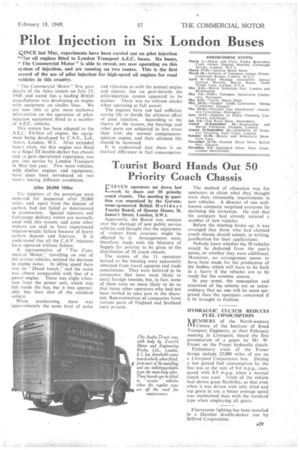Pilot Injection in Six London Buses
Page 5

If you've noticed an error in this article please click here to report it so we can fix it.
INCE last May, experiments have been carried out on pilot injection "—'for oil engines fitted to London Transport A.E.C. buses. Six buses, " [he Commercial Motor" is able to reveal, are now operating on this system of injection, and are running on two routes. This is the first record of the use of pilot injection for high-speed oil engines for road vehicles in this country.
"The Commercial Motor" first gave details of the Atlas system on July 23, 1948. and statecl that a leading British manufacturer was developing an engine with equipment on similar lines. We are now able to give more exclusive information on the operation of pilotinjection equipment fitted to a number of A.E.C. vehicles.
This system has been adapted to the A.E.C. 9.6-litre oil engine, the equipment being developed by C.A.V„ Ltd., Acton, London, W.5. After extended bench trials, the first engine was fitted to a Regal Ill double-decker bus chassis and, to gain operational experience, was put into service by London Transport in May last year. Five more irehicles, with similar engines and equipment, have since been introduced on two • routes having different conditions.
After 20,000 Miles The injectors of the prototype were removed for inspection after 20,000 miles, and, apart from the deposit of carbon, had not failed or deteriorated in atomization. Special injectors and fuel-pump delivery valves are normally used with this system, and some other makers are said to have experienced injector-nozzle failure because of heavy carbon deposit and fracture. It is understood that all the C.A.V. injectors have operated without failure.
A representative of "The Commerc;al Motor," travelling on one of the service vehicles, noticed the decrease in engine noise. At idling speed there was no "Diesel knock," and the noise was almost comparable with that of a petrol engine. There was slight vibration from the power unit, which was felt inside the bus, but it was appreciably less than that of the standard vehicle.
When accelerating, there was approximately the same level of noise and vibration as with the normal engine and chassis, but on part-throttle the pilot-injection system appeared to be quieter. There was no exhaust smoke when operating at full power.
The engines have not had sufficient service life to decide the ultimate effect of pilot injection. According to the theory of the system, the bearings and other parts are subjected to less stress than with the normal compressionignition engine, and their ulitmate life should be increased.
It is understood that there is no marked difference in fuel consumption.


























